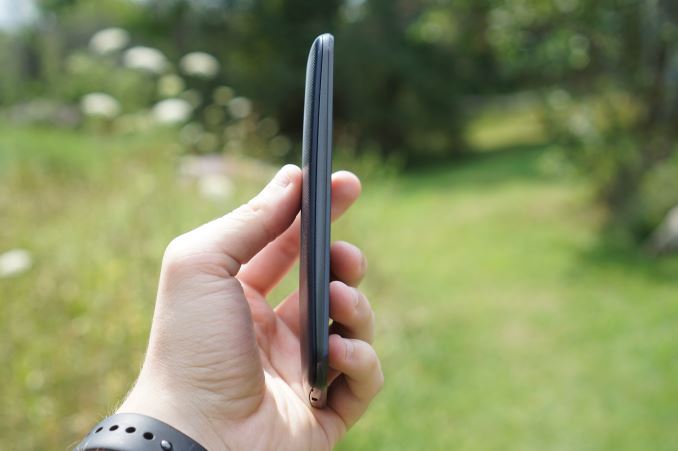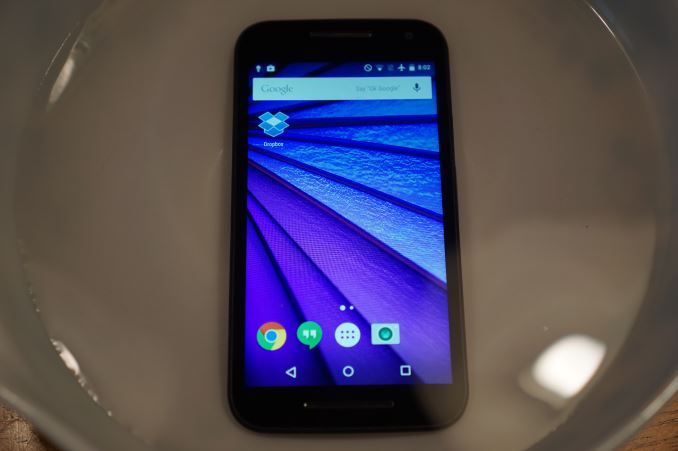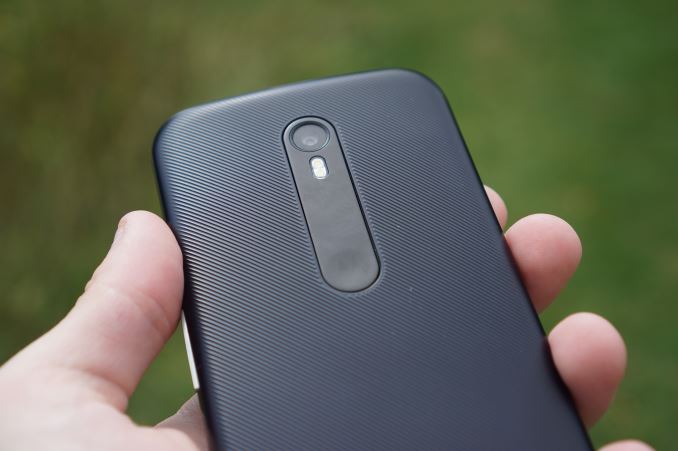The Moto G (2015) Review
by Brandon Chester on August 19, 2015 8:00 AM EST- Posted in
- Smartphones
- Mobile
Final Words
When Motorola launched the 2014 Moto G I felt that it was something of a sidegrade rather than a straight upgrade. The larger display size wasn't accompanied by an increase in resolution, but it did come with improvements to color accuracy. The cameras also received an upgrade, and you got a microSD slot, but every other aspect of the device was unchanged. The 2015 Moto G really feels like the first major upgrade to the phone since the original version launched in 2013.
As far as design and build quality goes, if you're a fan of Motorola's industrial design you'll like the 2015 Moto G, and if you don't like it your mind isn't likely to be changed by it. I think the Moto G has a good feel in the hand and it's not as slippery as the Moto E because of the textured back. The flex around the edges is difficult for me to ignore though, especially when the less expensive Moto E with its non removable back feels much more solid as a result. The waterproofing is definitely a neat addition, but I think in most cases it's just a nice thing to have rather than a selling point. Once waterproofing is accompanied by the ability to use the display when it's really wet I'll be a lot more interested in it.
Speaking of the display, that's one of the areas of the Moto G that disappointed me. The improvement to brightness over the 2014 model is greatly appreciated, but it's still quite reflective and the capacitive touch sensors show up very easily in light which makes it difficult to use outdoors. The calibration also takes a hit in every respect, and unfortunately I would have to describe the 2015 Moto G's display as an overall downgrade from the 2014 model.
When it comes to performance, the 1.4GHz Snapdragon 410 paired with 2GB of RAM is a definite improvement over the 1.2GHz implementation with 1GB of RAM in the Moto E. In fact, CPU performance is almost as fast as devices that use the 1.5GHz version of Snapdragon 615 such as the Huawei P8 Lite. Unfortunately, the Adreno 306 GPU is not very fast to say the least, and that leaves a graphics performance gap between the Moto G and Snapdragon 615 devices. The Zenfone 2 is also a device to consider, with approximately the same price as the 16GB/2GB model of the Moto G, a better display, and significantly higher performance.
While the Zenfone 2 is definitely a faster device than the Moto G, it falls short when it comes to the quality of photos and videos. In fact, I think that the new rear camera in the Moto G is one of its most substantial improvements. IMX214 was a good camera sensor in the Nexus 6, and it's even more impressive to see in a device that starts at $179. Comparisons between the two devices definitely highlights a gap in ISP performance, particularly when examining video quality, but I think the Moto G has the best camera when compared to other mid range devices that I've used.
The last important aspect of the new Moto G to consider is its battery life. While it's certainly not as fast as a device like the Zenfone 2, it has outstanding battery life in a variety of scenarios. It's unfortunate that battery life in heavy CPU workloads is hampered by the high leakage of the 28nm LP process, but in the sort of tasks Moto G users will be performing the battery life is longer than any other mid range phone, and is often twice as long as the Zenfone 2.
This ends up presenting buyers with a choice. One can opt for the larger, faster Zenfone 2 with its better display, but they lose out on camera quality and battery life. If one chooses the Moto G, they sacrifice performance and display resolution for a smaller device with much longer battery life and a camera that is on a completely different level. While users all have different preferences for the features that are important to them, I think whether they choose the Moto G or a device like the Zenfone 2 depends on how much battery life they need.
In the end, I think as far as conventional mid range devices goes there's no competition for the Moto G. The construction and the camera are good, the performance is the best of an ARM device at this price point, and the battery life is amazing. If you feel that the Moto G's performance isn't fast enough for you then the Zenfone 2 is definitely a device to consider, but I think the Moto G strikes a good balance of performance, features, and battery life, and ends up being the best choice for the average buyer looking to buy a mid range smartphone.














90 Comments
View All Comments
3DoubleD - Wednesday, August 19, 2015 - link
Thanks for the response!1. The 5W charging time would be great! Thanks for adding that.
2. I agree, it is too bad they are hamstringing the GPUs in these devices. Three generations of Moto G including the same GPU is pretty disappointing. It seems Motorola is keeping customers interested in AAA gaming on their more expensive phones, which is understandable. From what you are saying, it sounds like the poor display calibration and poor visibility in sunlight would be more apparent to non-gamers than the GPU.
3. What I'm referring to is your comments in the concluding remarks: "The waterproofing is definitely a neat addition, but I think in most cases it's just a nice thing to have rather than a selling point. Once waterproofing is accompanied by the ability to use the display when it's really wet I'll be a lot more interested in it." I suspect many people will see waterproofing as a selling point (AKA a desirable feature) just from a pure ruggedness standpoint. Instances where people are deciding between several mid-range Android phones and pick the Moto G based on it being waterproof are probably more likely than decisions based on many of the other specs.
4. My problem with device thinness is that the benefit of thinner and thinner devices is dubious, yet the benefit for keeping the same thickness, or even increasing it, is substantial. I don't think a objective argument can be made for why a 6.9 mm phone is better than a 8 mm phone or even an 11.6 mm phone (like the Moto G). Even the subjective 'design' argument is pretty shaky, considering everyone was swooning over smartphone designs that first made it to 10 or 11 mm.
So as leading reviewer of phones and a spokesperson for the masses, I'd challenge you to develop a metric for phone thickness that equally considers 'thin design' with ease of use and battery life. IMO manufacturers hit the thin-enough-to-be-usable limit years ago. Let's stop praising thinness-at-all-costs in reviews (as is typical in a flagship Android or iPhone review) and start making a big deal when the design needlessly sacrifices battery life for thinness.
djc208 - Wednesday, August 19, 2015 - link
Seems to me the one major category that is missed between those two phones is support. More and more I'm just as interested in how it will be supported, and I wonder how well the Zenphone will be supported against future OS updates. I'd tend to lean toward Motorola for long term support. LG brought be in with great hardware but turned me off with crappy software support.Moto1 - Wednesday, August 19, 2015 - link
Zero support from Motorola. Emailed and called and all I get is generic replys-not related to my question. I bought the first moto g in anticipation of fast updates and have had zero-which sucks cause I was promised 5.0 over a year ago.Machete - Thursday, August 20, 2015 - link
False, we have a 1g Moto G in family and it was updated to 5.0 months ago.tipoo - Sunday, August 23, 2015 - link
Must be your carriers fault. My first gen G has been rocking 5 for months.tipoo - Wednesday, August 19, 2015 - link
MicroSD and 2GB RAM were the two things I sorely missed in my first gen G, so this looks like a fair upgrade. Honestly, it's all the phone most people need. Even the weak GPU runs most modern Android games well. The RAM was always the bigger issue than the processing speed, and the minor bump to the latter will be a nice bonus.Now just bring Moto Maker for the G to Canada and take my money, Motorola!
YukaKun - Wednesday, August 19, 2015 - link
So... Is this better than my SGS2? Y know the CPU is better, but is the camera and GPU?I'm having a considerable loss in battery life as of late (from 3 days to just 2) and the S2 is still running anything I need it to (GMail, GMaps and other "light" stuff) with no hiccups. So in my mind, instead of getting a battery replacement, maybe jumping to the MotoG 2015 might be a good idea.
Cheers!
a1exh - Wednesday, August 19, 2015 - link
Battery replacements are soooo cheap for the SGS2 though. If it is still going and you're happy. The SGS2 camera was better than the MotoG 2013a1exh - Wednesday, August 19, 2015 - link
As a MotoG 2013 customer I wanted the 2015 to be great. But it isn't. So the Vodafone Smart Ultra 6 is looking like the PAYG phone to get in the UK only it is a bit bigmkozakewich - Wednesday, August 19, 2015 - link
Devices like this really highlight the need for colour correction on Android. If it can fill the full sRGB gamut, the only thing left is to tell it where to put the colours. There's no reason something like this shouldn't be able to pull a dE2000 of 1.I remember the review of the Stream 7. Since it ran Windows, they were able to run a correction suite on it, and it ended up with a really good score despite its inability to saturate the blues.